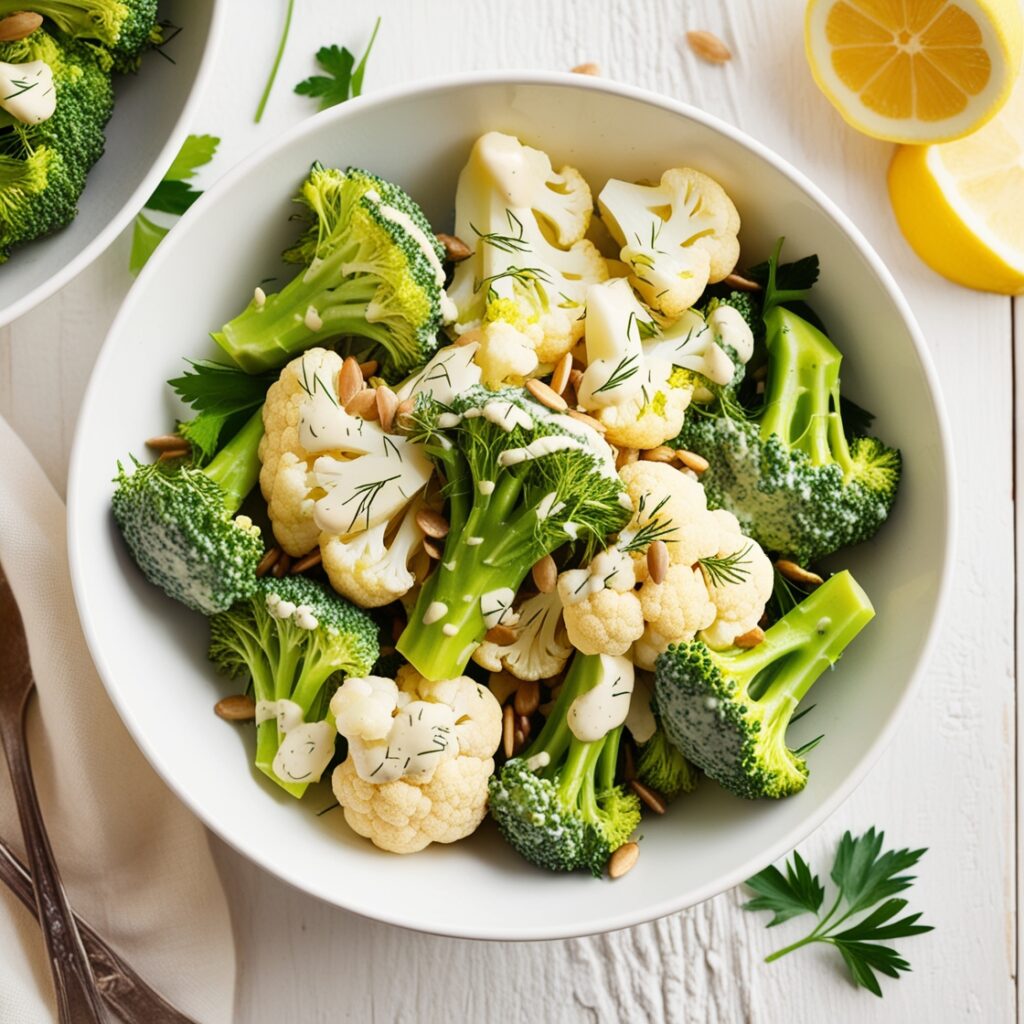In today’s health-conscious world, finding nutritious yet delicious meals can often feel like a daunting task. However, embracing fresh, vibrant ingredients can transform your dining experience while bolstering your well-being. Enter the Broccoli Cauliflower Salad Recipe, a delightful medley that not only tantalizes the taste buds but also provides a wealth of nutritional benefits. Packed with essential vitamins, minerals, and fiber, this salad is a versatile dish that can serve as a refreshing side or a satisfying main course.
Its vibrant colors and crisp textures make it an appealing addition to any meal, whether you’re hosting a summer barbecue, preparing a weekday lunch, or seeking a wholesome option for family gatherings. In this article, we will delve into a simple yet flavorful Broccoli cauliflower salad recipe, enhanced with a zesty dressing and an assortment of complementary ingredients. Join us as we explore how this salad can elevate your culinary repertoire, offering not just a burst of flavor but also a commitment to a healthier lifestyle. Prepare to embrace a dish that exemplifies the perfect balance of taste and nutrition, making it a must-try for anyone looking to incorporate more wholesome options into their meals.
Nutritional Benefits of Broccoli Cauliflower Salad Recipe
Broccoli and cauliflower are cruciferous vegetables that offer a wealth of nutritional benefits, making them valuable additions to a balanced diet. Both are low in calories yet high in essential vitamins and minerals, particularly vitamin C, vitamin K, and folate. Their high fiber content promotes digestive health and helps maintain a feeling of fullness, which can be beneficial for weight management. Additionally, these vegetables contain various phytonutrients and antioxidants that contribute to anti-inflammatory effects and may support overall immune function.
The presence of compounds such as sulforaphane, found particularly in broccoli, has been extensively studied for its potential role in cancer prevention. Cauliflower, on the other hand, is rich in choline, a nutrient that supports brain health and cognitive function. Together, these vegetables can enhance nutrient intake and contribute to long-term health outcomes when included in meals regularly. Incorporating them into salads not only boosts nutritional value but also adds a delightful crunch and a variety of textures to the dish.
Discover the health advantages of these nutrient-rich vegetables in your diet.
Incorporating Broccoli cauliflower salad recipe into your meals can significantly enhance your nutrient profile, offering a variety of health advantages. These vegetables are not only packed with vitamins and minerals, but they also provide essential antioxidants that combat oxidative stress in the body. Their high fiber content is beneficial for gut health, aiding in digestion and promoting a balanced microbiome, which is crucial for overall wellness. Regular consumption of these vegetables may help lower the risk of chronic diseases, including cardiovascular issues and certain types of cancer, as their bioactive compounds support healthy cellular functions.
Moreover, Broccoli cauliflower salad recipe with its versatile ingredients that can easily be integrated into various culinary preparations, from salads to stir-fries. Their unique flavors and textures can enhance the appeal of a wide range of dishes while delivering substantial health benefits. By incorporating these nutrient-rich vegetables into your diet, you not only enjoy their delicious taste but also invest in your long-term health and well-being.
Essential Ingredients for the Salad

In crafting a vibrant and nutritious salad, a balance of textures and flavors is key. Fresh, crisp vegetables such as bell peppers, cucumbers, and cherry tomatoes can provide a colorful contrast to the hearty broccoli and cauliflower. Incorporating ingredients like red onions or scallions adds a mild sharpness that complements the more subdued flavors of the cruciferous vegetables. Additionally, including a variety of leafy greens, such as spinach or arugula, not only boosts the salad’s nutrient density but also contributes a refreshing crunch.
To elevate the dish further, consider adding protein sources like chickpeas, grilled chicken, or feta cheese, which enhance satiety and create a more fulfilling meal. Nuts or seeds can provide an enjoyable crunch and healthy fats, while a simple dressing of olive oil, lemon juice, and herbs introduces a zesty element that ties all the ingredients together. This harmonious blend of components not only results in a visually appealing presentation but also ensures a robust and satisfying salad that is both nourishing and enjoyable.
“Craving something delicious? Dive into our Tasty Chicken Salad Chick Recipe.”
Learn about the key components needed for a delicious Broccoli cauliflower salad recipe.
The addition of herbs and spices can significantly enhance the overall flavor profile of a broccoli cauliflower salad recipe. Fresh herbs such as parsley, dill, or basil can impart a bright and aromatic quality, while spices like garlic powder or black pepper provide depth. For those who enjoy a bit of heat, a sprinkle of red pepper flakes can infuse the dish with a subtle kick, making each bite more exciting.
Furthermore, considering the salad’s presentation is just as important as its taste. Arranging the ingredients in a visually appealing manner—layering the vibrant vegetables with contrasting colors and textures—can elevate the dining experience. A drizzle of dressing just before serving allows for an enticing sheen that invites enjoyment. Ultimately, the combination of fresh ingredients, proteins, and thoughtful seasonings creates a balanced salad that is both satisfying and delightful.
Simple Preparation Steps Explained
To prepare a broccoli cauliflower salad recipe efficiently, start by gathering all ingredients and tools at your workspace. Begin by washing the broccoli and cauliflower thoroughly under cold water to remove any dirt or residue. Once clean, cut the vegetables into bite-sized florets, ensuring uniformity for even cooking or mixing. Blanching the vegetables briefly in boiling water before plunging them into ice water can enhance their color and texture, providing the perfect crispness for the salad.
Next, it is essential to prepare any additional components, such as chopped herbs, nuts, or proteins, while the vegetables cool. This multi-tasking can save time and maintain momentum in the preparation process. Once all elements are ready, combine them in a large mixing bowl, add your choice of dressing, and toss gently to coat. Allowing the salad to sit for a few minutes before serving can help the flavors meld together, resulting in a more harmonious dish that showcases the freshness of the ingredients.
Follow easy-to-understand steps to prepare your fresh and healthy salad quickly.
Incorporating fresh ingredients is key to achieving a vibrant and nutritious broccoli cauliflower salad recipe. Selecting ripe, seasonal produce not only enhances flavor but also boosts the overall health benefits of your meal. Complement the colorful florets with a variety of textures and tastes by adding items such as cherry tomatoes, bell peppers, or red onions. These additions not only contribute nutritional value but also elevate the visual appeal of the dish.
To create a well-balanced salad, consider incorporating a source of protein, such as chickpeas, grilled chicken, or cheese, which can transform the salad into a more filling option. Drizzling a light vinaigrette or yogurt-based dressing can bring all the flavors together while keeping the dish light and refreshing. With minimal effort, this quick and healthy salad can serve as a delightful side or a satisfying main course, ideal for any meal of the day.
Adding Flavor with Dressings

Dressings play a pivotal role in enhancing the overall flavor profile of a salad, acting as the finishing touch that ties all the elements together. A well-crafted dressing can elevate simple ingredients, imparting a layer of complexity that tantalizes the palate. For a broccoli cauliflower salad recipe, consider using a zesty lemon vinaigrette or a creamy tahini dressing, each offering distinct notes that complement the earthy flavors of the vegetables. The acidity from citrus or vinegar can brighten the dish, while creamy options can provide a comforting richness that balances out the crunchiness of the fresh produce.
Furthermore, the versatility of dressings allows for endless customization, catering to various dietary preferences and taste profiles. Herb-infused olive oils, spiced yogurt blends, or even nut-based sauces can introduce new dimensions to the salad. Experimenting with different combinations not only personalizes the dish but also encourages creativity in the kitchen, inviting you to explore a favorite dressing that enhances the overall meal experience. By carefully selecting and crafting your dressings, you can transform a simple salad into a delightful culinary adventure.
Explore different dressing options to enhance the taste of your salad.
the kitchen. A tangy balsamic reduction can add a sweet depth, while a garlic-infused vinaigrette may impart a robust punch, appealing to those who enjoy bold flavors. Additionally, incorporating ingredients such as honey, Dijon mustard, or fresh herbs can further refine the dressing, allowing for both traditional and innovative variations that are sure to impress.
For those seeking a healthier option, yogurt-based dressings can provide a lighter alternative without sacrificing flavor. The addition of spices like cumin or smoked paprika can transform a simple yogurt base into a zesty companion for the broccoli and cauliflower. Not only does this approach enhance the dish’s taste, but it also enriches its nutritional profile, making it a compelling choice for health-conscious diners. The key lies in balancing flavors and textures, ensuring that each bite remains an exciting exploration of taste.
Customizing Your Broccoli cauliflower salad recipe
Salad customization offers endless possibilities to cater to personal tastes and dietary needs, allowing you to create a dish that is uniquely yours. Start with a base of fresh greens or a blend of cruciferous vegetables, and build upon it with an array of toppings such as roasted nuts, seeds, or whole grains to add crunch and heartiness. Incorporating seasonal fruits can introduce natural sweetness, while adding proteins like grilled chicken, chickpeas, or feta cheese can provide much-needed sustenance.
Texture plays a vital role in the overall appeal of your salad; combining crisp, tender, and creamy ingredients can create a delightful mouthfeel. Exploring various flavor combinations, such as contrasting sweet and savory elements or incorporating spicy components, allows for a multi-dimensional experience that keeps each serving exciting. Ultimately, the goal of customization is to transform your salad into a delightful, nourishing dish that reflects your preferences while showcasing a vibrant array of ingredients.
Tips for personalizing your broccoli cauliflower salad recipe with additional ingredients or toppings.
Consider enhancing your broccoli cauliflower salad by incorporating a variety of colorful vegetables, such as bell peppers, carrots, or cherry tomatoes, which not only add visual appeal but also contribute essential nutrients. Incorporating herbs like parsley, dill, or basil can elevate the freshness and add aromatic qualities, while a sprinkle of grated cheese—such as Parmesan or cheddar—can introduce a savory richness that complements the textures of the broccoli and cauliflower.
For those who enjoy a bit of zest, a drizzle of vibrant dressings or a splash of citrus juice can awaken the flavors and balance the earthy notes of the vegetables. Experimenting with different nuts, such as sliced almonds or walnuts, not only enhances the crunch factor but also infuses healthy fats into the mix. With these thoughtful additions, your salad can transition from a side dish to a satisfying meal that caters to diverse palates and dietary preferences.
Perfect Pairings for Your Salad
To further elevate your salad experience, consider pairing it with proteins that not only enhance its nutritional value but also complement its flavors. Grilled chicken, shrimp, or even roasted chickpeas can provide a hearty element, making the salad more filling and satisfying. Additionally, incorporating a side of whole-grain bread or a light grain such as quinoa or farro can create a balanced meal that is rich in fiber and essential nutrients.
For a refreshing beverage accompaniment, a chilled herbal tea or infused water can serve as an ideal partner, cleansing the palate and enhancing the overall dining experience. A light white wine or a crisp sparkling beverage could also harmonize beautifully with the fresh flavors of the salad, making it suitable for casual lunches or more formal gatherings. By thoughtfully considering these pairings, you’re not only enhancing your salad but also curating a delightful meal that engages the senses.
Suggestions for side dishes that complement your broccoli cauliflower salad recipe perfectly.
A variety of side dishes can beautifully complement the vibrant flavors and textures of a broccoli cauliflower salad. Roasted or grilled vegetables, such as asparagus or bell peppers, offer a smoky contrast while retaining a crispness that echoes the freshness of the salad. Additionally, a light potato salad dressed with a tangy vinaigrette can introduce a hearty element without overwhelming the palate, allowing the salad to remain the centerpiece of the meal.
For those seeking a grain-based option, a simple pilaf made with wild rice and herbs can enhance the salad’s earthy tones, providing a satisfying balance. Alternatively, a refreshing fruit salad featuring seasonal produce can add a sweet contrast, enhancing the overall flavor profile while delivering a burst of color to the table. Each of these side dishes not only complements the salad but also contributes to a well-rounded and enjoyable dining experience.
Nutritional Comparison of Salad Variations
When evaluating the nutritional profile of various salad variations, it becomes clear that ingredient choices significantly impact their health benefits. For instance, salads featuring cruciferous vegetables, such as broccoli and cauliflower, are rich in vitamins C and K, fiber, and various antioxidants, promoting overall health and potentially reducing the risk of chronic diseases. In contrast, salads that include starchy ingredients like pasta or potatoes may provide additional energy but can significantly increase carbohydrate content, which may not align with certain dietary goals.
Furthermore, the addition of protein sources, such as legumes, grilled chicken, or nuts, can enhance the nutritional value by providing essential amino acids while also contributing to satiety. Dressings should also be considered, as those based on olive oil or yogurt offer healthier fats and lower calories compared to creamy or sugary options. Ultimately, understanding the nutritional differences among various salad components allows for more informed choices that align with individual dietary needs, leading to a more balanced and health-conscious meal.
Check out the health differences between traditional and healthier salad ingredient choices.
The choice of ingredients in salads can dramatically influence their overall healthfulness. For instance, incorporating leafy greens like spinach or kale instead of iceberg lettuce can enhance the vitamin and mineral content of the dish, as these greens are packed with nutrients like iron, calcium, and antioxidants. Additionally, opting for a variety of colorful vegetables, such as bell peppers, tomatoes, and carrots, not only elevates the visual appeal but also increases the diversity of phytonutrients that may support immune function and reduce inflammation.
Moreover, the selection of toppings and dressings plays a crucial role in the health profile of salads. Replacing high-calorie, processed toppings like croutons or bacon bits with seeds, nuts, or a sprinkle of cheese can add healthy fats and protein, making the salad more satisfying without compromising nutritional value. Choosing vinaigrettes made from healthy oils and vinegar over heavy creamy dressings can also significantly reduce calorie intake while providing beneficial fats. By being mindful of these choices, individuals can create salads that not only taste great but also align with their health objectives.
Storing Leftover Salad Safely
To ensure that leftover salad remains safe for consumption, it is essential to store it properly. First, transfer any uneaten portions into an airtight container to minimize exposure to air, which can lead to spoilage. It is advisable to separate the dressing from the salad base if possible, as moisture from the dressing can cause the greens to wilt and lose their texture. When stored in the refrigerator, salads should ideally be consumed within three days to maintain freshness and quality.
When reheating or repurposing leftover salad, it’s important to inspect it for any signs of spoilage, such as off smells or discoloration. If the salad has been left out at room temperature for more than two hours, it should be discarded to avoid foodborne illness. By adhering to these guidelines, one can enjoy the nutritional benefits of salads while minimizing waste and ensuring food safety.
Best practices for storing leftover salad to maintain freshness and flavor.
To retain the freshness and flavor of leftover salad, consider incorporating elements that enhance preservation. Adding a small piece of paper towel inside the container can help absorb excess moisture, preventing the greens from becoming soggy. Additionally, if your salad contains delicate ingredients such as avocado or tomatoes, it’s beneficial to store these separately or in a more controlled manner to avoid rapid degradation.
When arranging the ingredients in the container, layer the heartier items like cucumbers or bell peppers at the bottom and the more fragile greens on top. This strategic layering minimizes bruising and damage during storage. For optimal flavor, be sure to consume the salad within a couple of days, and if possible, add any fresh toppings or dressings just before serving to enhance the overall taste and texture.
In conclusion, the Broccoli Cauliflower Salad Recipe is not only a vibrant and nutritious addition to any meal, but it also embodies the essence of healthy eating without sacrificing flavor. With its colorful array of vegetables and a delightful dressing, this salad offers a perfect balance of textures and tastes that can complement a wide variety of dishes. Whether served as a side at a family gathering or as a light lunch option, this recipe is versatile and easy to prepare. By incorporating this salad into your meal rotation, you can enjoy the health benefits of cruciferous vegetables while delighting your palate, making it a must-try for anyone looking to enhance their culinary repertoire.
FAQ
Sure! Here are five questions related to a Broccoli Cauliflower Salad Recipe:
- What ingredients are needed for the broccoli cauliflower salad recipe?
- How do you prepare the Broccoli cauliflower salad recipe?
- What dressing is typically used for this salad?
- Can I add other vegetables or proteins to the salad?
- How should the salad be stored and for how long?
What are the key ingredients needed to prepare a classic Broccoli Cauliflower Salad Recipe?
To prepare a classic Broccoli Cauliflower Salad Recipe, you’ll need fresh broccoli florets, cauliflower florets, and cooked bacon pieces. Additional ingredients typically include red onion, shredded cheese (like cheddar), and sunflower seeds. For the dressing, combine mayonnaise, sugar, and vinegar to create a creamy, tangy flavor. Optional additions may include raisins or nuts for extra texture. Mix the vegetables, bacon, and dressing thoroughly, then chill before serving for the best taste.
How can you customize the Broccoli Cauliflower Salad Recipe to suit different dietary preferences, such as vegan or gluten-free?
To customize Broccoli Cauliflower Salad Recipe for different dietary preferences, use vegan mayonnaise or tahini instead of regular mayo for a vegan option. For gluten-free diets, ensure all ingredients, including any dressings or toppings, are certified gluten-free. Add nuts or seeds for extra protein and crunch, and include legumes like chickpeas for a heartier salad. Incorporate a variety of vegetables, such as bell peppers or carrots, to enhance flavor and nutrition. Additionally, use herbs and spices to boost taste without compromising dietary needs.
What dressing options pair well with Broccoli Cauliflower Salad Recipe, and how can they enhance the overall flavor of the dish?
Dressing options like creamy ranch, tangy vinaigrette, or a light yogurt-based dressing pair well with Broccoli Cauliflower Salad Recipe. Creamy ranch adds richness, enhancing the salad’s crunchiness, while a tangy vinaigrette introduces brightness, balancing the vegetables’ earthiness. A yogurt-based dressing provides a healthier alternative, offering a slight tang that complements the salad’s flavors. Each dressing option enhances the overall flavor profile, adding depth and making the salad more enjoyable while harmonizing with the fresh, crisp textures of broccoli and cauliflower.
What are some tips for preparing and storing Broccoli Cauliflower Salad Recipe to maintain its freshness and crunchiness?
To maintain the freshness and crunchiness of Broccoli Cauliflower Salad Recipe, prepare it just before serving. If prepped in advance, store the salad in an airtight container in the refrigerator to minimize exposure to air. Use fresh, crisp vegetables and avoid watery dressings; consider adding the dressing just before serving. Keep components, like nuts or seeds, separate until serving to prevent sogginess. For added crunch, incorporate ingredients like crispy bacon or croutons just before eating. Finally, consume the salad within 2-3 days for optimal freshness.
How can you incorporate additional nutrients or flavors into a Broccoli Cauliflower Salad Recipe, such as nuts, seeds, or fruits?
To enhance a Broccoli Cauliflower Salad Recipe, incorporate ingredients like chopped nuts (walnuts or almonds) for crunch, seeds (pumpkin or sunflower) for added nutrition, and fruits (dried cranberries or fresh apples) for sweetness. You can also add crumbled feta or shredded cheese for creaminess. Drizzling with a tangy vinaigrette or yogurt-based dressing can elevate the flavors further. Experiment with herbs like dill or parsley for freshness and a pop of color. These additions not only boost the nutritional profile but also create a delightful mix of textures and tastes.


2 thoughts on “Broccoli Cauliflower Salad Recipe: A Fresh and Healthy Addition to Your Meals”